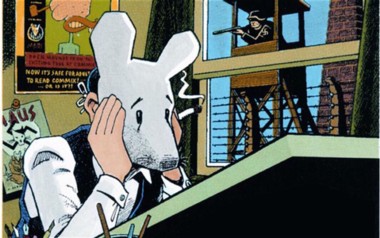As a younger man, I dreamed of being an artist. Not in the classical sense, perhaps—I never imagined myself chiseling away at great blocks of Carrara marble, or one-upping Leonardo’s famous smile. Instead, I was drawn mostly to the Sunday funnies and comic books, where Popeye’s outlandishly oversized forearms made a kind of freakish sense, and an imaginary tiger led his friend Calvin on wild adventures. Somehow, those scenes felt more real to me than any Mona Lisa.
It was a fascination that began early, fueled by growing up in a beach town, where there were always caricaturists plying their trade in a corner of downtown. I armed myself with a fistful of Sharpies and set out on the path early, selling drawings of Garfield for a quarter each to my grade-school classmates. (Note to aspiring artists: those remain some of my biggest sales.) But in the mid-1980s, my father brought home a book that would blow apart my sense of art forever: Maus.
Art Spiegelman’s most famous book, subtitled “A Survivor’s Tale” and with a Hitler quote as an epigraph, this early “graphic novel” was—and still is, really—unlike any cartoon I’d seen before. (Many agreed; it became the first book of its kind to win a Pulitzer.) A personal recollection of the Holocaust years as told to Spiegelman by his father, it makes that terrible history paradoxically more human by depicting its players as cats (the Nazis) and mice (the Jews), among other animals. I think people are caught off guard on first opening the book; hand-drawn images tend to inspire feelings of warmth or comfort, which makes the emotional punch of Spiegelman’s story so much more wrenching. Even for a Catholic kid drinking coffee milk in Rhode Island, it hit home.
This week, the Pioneer Valley Jewish Film Festival kicks off its two-week run with a film that explores the man’s amazing worlds. The Art of Spiegelman, screening Thursday, April 4 at 7 p.m. on the Mount Holyoke campus, draws back the curtain, revealing the artist at work and at home as he and his wife (New Yorker art editor Francoise Mouly) banter and bicker. Helping to illuminate Spiegelman’s place in art history is a panel of guest speakers from Mount Holyoke’s Jewish studies program and the UMass comparative literature program.
Screening with the documentary are two films directed by Sam Ball; Joann Sfar Draws from Memory and the five-minute short People of the Graphic Novel. The first focuses on the 39-year-old Sfar, a prolific artist whose output encompasses over a hundred books, including best-sellers here and abroad. Algerian and Eastern-European Jewish by heritage, Sfar has adopted Paris—the land that made his Rabbi’s Cat a hit—as his home. Ball’s film captures his improvisatory working methods and his thoughts on creativity as well as his frustration with critics who try to pigeonhole him as a “Jewish artist.” People of the Graphic Novel, on the other hand, looks at the wider history of comics as an American art form—one that is filled with the dreams of the Jewish kids who helped create it. (For more on that idea, Michael Chabon’s The Amazing Adventures of Kavalier & Clay is a great, if not exactly historical, read.)
Also this week: Speaking of American art forms, that most famous of them all—jazz—takes center stage at Amherst Cinema on Monday, April 1st when WFCR’s Tom Reney (host of the station’s Jazz à la Mode program) presents The Savoy King in a 7 p.m. show. A biography of Chick Webb, it tells the story of one of jazz’s often overlooked giants.
Born in 1905 to a poor family and afflicted early with spinal tuberculosis, Webb faced a life of hardship. But it all turned around when the young man took up drumming as physical therapy—from the start, it was obvious he was something special. At 16 he lit out for New York from his native Baltimore, building the best jazz orchestra in America. His home court was the Savoy Ballroom in Harlem, where—a rarity in the era—black and white audiences could come together to enjoy his sounds.
Those who knew him, played with him, or were discovered by him stitch his story together in interviews, while period footage gives us a tantalizing taste of his time.•
Jack Brown can be reached at cinemadope@gmail.com.



